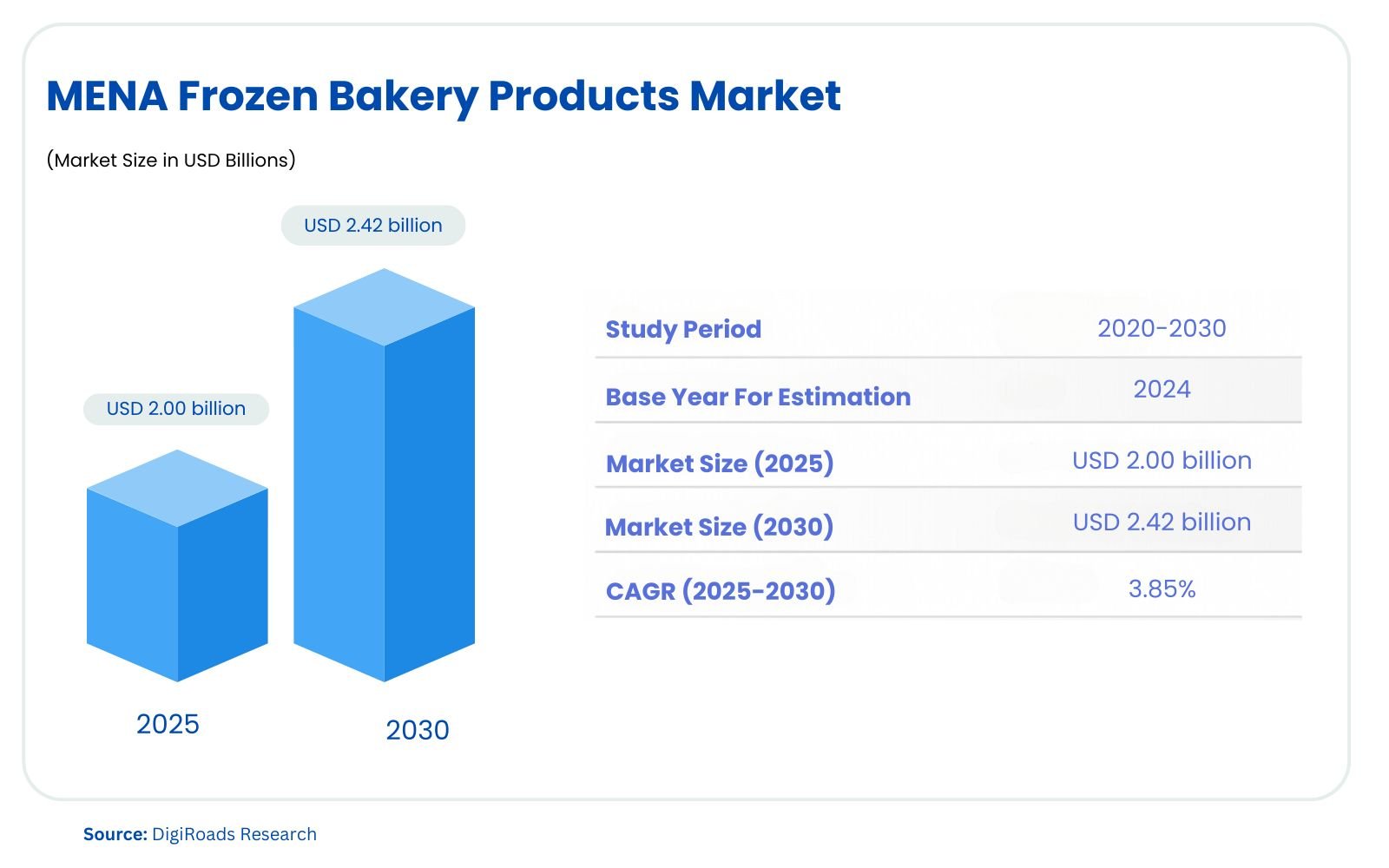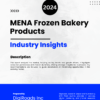No products in the cart.
MENA Frozen Bakery Products
- Brand: DigiRoads
Discover the 100+ page report on the MENA Frozen Bakery Products Market, providing insights into trends, growth drivers, and the competitive landscape. Available in PDF and Excel formats for easy access to detailed data and analysis.
Category: Food and Beverage
Brand: DigiRoads
MENA Frozen Bakery Products Market Report | Market Size, Industry Analysis, Growth Opportunities, & Forecast (2025-2030)
MENA Frozen Bakery Products Market Overview
The MENA Frozen Bakery Products Market is on a steady rise, with an estimated market size of USD 2.00 billion in 2025, and it is forecasted to reach USD 2.42 billion by 2030, expanding at a CAGR of 3.85% during the forecast period 2025-2030. The MENA (Middle East and North Africa) frozen bakery products market is experiencing significant growth, driven by changing consumer preferences, the demand for convenience, and the increasing popularity of ready-to-eat food options. The market encompasses a wide range of frozen products, including bread, pastries, cakes, and other baked goods. The rise in working professionals, busy lifestyles, and the growing adoption of Western eating habits are fueling the demand for frozen bakery products in the region.
Key players in the MENA frozen bakery market are leveraging advanced technology to offer a diverse range of high-quality frozen products that cater to regional tastes. Innovations in packaging and distribution are also contributing to the market’s expansion by ensuring better product freshness and accessibility.
This report provides an in-depth analysis of the market trends, key drivers, challenges, and opportunities within the MENA frozen bakery sector. It also highlights the competitive landscape and forecasts growth trends for the upcoming years, offering valuable insights for industry stakeholders looking to capitalize on the growing demand in this dynamic market.
Market Report Coverage:
The “MENA Frozen Bakery Products Market Report—Future (2025-2030)” by Digiroads Research & Consulting covers an in-depth analysis of the following segments in the market.
| Product Type | Bread, pastries, cakes, and other baked goods. |
| Distribution Channel | Retail, online sales, and food service channels. |
| Packaging Type | Standard packaging, eco-friendly packaging, and convenience packaging. |
| Geography | North Africa, GCC countries, Levant, and other MENA region |
Study Assumptions and Definitions
This study on the MENA frozen bakery products market is based on several key assumptions that influence the analysis and projections. It assumes that consumer demand for convenience food products will continue to rise in the region, driven by factors such as busy lifestyles, urbanization, and the increasing preference for ready-to-eat products. Additionally, the research assumes that technological advancements in food preservation, packaging, and production will continue to enhance the shelf-life and quality of frozen bakery items, contributing to market growth.
Definitions for the purposes of this study are as follows:
- Frozen Bakery Products: Refers to any bakery item, such as bread, pastries, cakes, and other baked goods, that is produced, frozen, and sold for later consumption.
- MENA Region: Encompasses the Middle East and North Africa, including countries such as Saudi Arabia, UAE, Egypt, Morocco, and others.
- Market Growth: Refers to the increase in demand and revenue generation within the MENA frozen bakery market over a specified period.
- Consumer Type: Segmentation of market demand based on the end-user, which includes individuals, households, and commercial sectors such as foodservice and retail.
- Distribution Channels: Methods through which frozen bakery products reach consumers, including retail stores, online platforms, and food service establishments.
These assumptions and definitions guide the analysis, helping provide a clearer understanding of the MENA frozen bakery products market dynamics.
Market Scope
The scope of this report on the MENA frozen bakery products market covers a comprehensive analysis of market trends, growth drivers, challenges, and opportunities within the region. It includes an in-depth examination of key product categories such as bread, pastries, cakes, and other baked goods available in frozen form. The report highlights the demand across various consumer segments, including individual households, busy professionals, and commercial sectors like hotels, restaurants, and cafes.
Geographically, the scope spans the MENA region, encompassing North Africa, the GCC countries, and the Levant, each with distinct consumer preferences and consumption patterns. The study also covers various distribution channels, including retail outlets, online platforms, and foodservice establishments.
Furthermore, the report explores technological advancements in production and packaging, which are shaping the market. By analyzing current and future market trends, the report aims to provide insights into the competitive landscape and growth opportunities for industry stakeholders in the MENA frozen bakery products market.
MARKET OUTLOOK
Executive Summary
The MENA (Middle East and North Africa) frozen bakery products market is experiencing significant growth, driven by shifting consumer preferences towards convenience foods, rising disposable incomes, and changing lifestyles. As urbanization increases and busy, working professionals dominate the consumer base, the demand for ready-to-eat and easy-to-prepare food items, including frozen bakery products like bread, pastries, cakes, and other baked goods, has surged. The region’s growing inclination toward Western eating habits, coupled with the desire for convenience and variety, further supports market expansion.
This market study provides an in-depth analysis of the MENA frozen bakery products industry, examining key product categories, consumer segments, distribution channels, and regional trends. The report covers North Africa, the GCC (Gulf Cooperation Council) countries, and the Levant, recognizing the diverse culinary preferences across these regions. It highlights the role of technological advancements in improving product quality, shelf life, and packaging, which are essential for ensuring product freshness and accessibility.
The frozen bakery sector is also benefiting from innovations in packaging, with eco-friendly and convenience-oriented solutions being adopted to cater to both environmental concerns and consumer convenience. In addition, distribution channels such as retail stores, online platforms, and foodservice establishments are integral to ensuring the reach of these products to a wide consumer base.
The competitive landscape within the MENA frozen bakery market is evolving, with both local and international brands vying for market share. This report identifies key market players, industry trends, and potential opportunities for businesses aiming to tap into this growing market. It offers valuable insights for stakeholders, manufacturers, and investors seeking to make informed decisions in this dynamic sector, highlighting the prospects of significant growth and expansion in the coming years.
COMPETITIVE LANDSCAPE
The MENA Frozen Bakery Products is moderately fragmented, with regional and multinational players competing fiercely for market share.
Key Market Players
- Almarai Company
- L’Artisan Boulanger
- Barilla Group
- Western Bakery
- Pillsbury (General Mills)
- Britannia Industries
- Kronos Foods
- Iceland Foods
- MAGRABi Foods
- Bridgestone Bakery
Market Share Analysis
The MENA frozen bakery products market is characterized by a competitive landscape with both local and international players vying for market share. Key market players such as Almarai Company, Barilla Group, and Pillsbury dominate the market, leveraging strong brand recognition, extensive distribution networks, and high-quality product offerings. Among these, Almarai Company holds a significant share, especially in the GCC region, due to its established reputation and widespread distribution of frozen bakery goods.
International brands like Barilla and Pillsbury maintain a robust presence by catering to the growing demand for premium frozen bakery products and adapting to regional tastes. Local brands such as Western Bakery and MAGRABi Foods have successfully capitalized on consumer preferences for traditional and locally inspired bakery items, securing a solid foothold in their respective markets.
In terms of distribution, retail outlets and foodservice channels account for a large portion of sales, with increasing consumer demand for convenience and ready-to-eat products driving growth. E-commerce platforms are also emerging as an important channel for frozen bakery products, particularly in urban areas.
Overall, the market is expected to witness steady growth, with key players continuing to innovate and expand their presence through product diversification and strategic partnerships. Local and international companies are likely to intensify competition, particularly as consumer preferences evolve towards more diverse and convenient frozen bakery options.
MARKET DYNAMICS
Market Drivers and Key Innovations
The MENA frozen bakery products market is experiencing significant growth, driven by several key factors.
- Convenience and Changing Lifestyles: The increasing demand for convenience foods is one of the primary drivers. As urbanization rises and busy work schedules dominate, consumers seek quick, easy-to-prepare meals, boosting the popularity of frozen bakery products like bread, pastries, and cakes. The shift toward ready-to-eat food has led to a higher adoption of frozen bakery items across households and food service establishments.
- Growing Disposable Incomes: Rising disposable incomes, particularly in the GCC and other affluent regions, have increased consumers’ purchasing power. This allows for greater expenditure on high-quality, ready-to-eat, and premium frozen bakery products, particularly those from global brands like Barilla and Pillsbury.
- Western Dietary Influence: The growing adoption of Western eating habits in MENA has introduced new tastes and bakery preferences, such as a demand for sandwiches, croissants, and other international baked goods, further driving market expansion.
- Health and Quality Trends: Consumers are becoming more health-conscious, leading to innovations in healthier frozen bakery products. Brands are introducing options with reduced sugar, low-fat content, and whole grain ingredients to cater to this segment.
Key Innovations:
- Packaging Advancements: Companies are adopting innovative packaging solutions, including eco-friendly and convenience-oriented packaging, to enhance product shelf life and appeal to environmentally conscious consumers.
- Technology in Production: The use of advanced baking technologies and freezing techniques ensures the preservation of freshness and quality, contributing to higher consumer satisfaction.
Market Challenges
- High Distribution Costs: The cost of logistics and transportation can be high, especially in regions with less-developed infrastructure, affecting the overall pricing and profitability of frozen bakery products.
- Perishable Nature of Products: Despite advancements in freezing technology, frozen bakery products still have a limited shelf life, posing challenges in maintaining product freshness and quality, especially in regions with fluctuating temperatures.
- Cultural and Regional Preferences: MENA consumers have diverse and strong cultural preferences for local bakery products, which may not always align with international frozen bakery offerings. Adapting to these tastes can be challenging for foreign brands.
- Price Sensitivity: While there is a growing demand for premium products, a large portion of the MENA market is price-sensitive. Balancing quality with affordability remains a challenge for many players, particularly local producers.
- Competition from Fresh Bakery Products: Freshly baked goods remain highly popular in the region, with many consumers preferring them over frozen alternatives due to perceptions of freshness and taste. This creates strong competition for frozen bakery products.
- Supply Chain Issues: Disruptions in the global supply chain, particularly due to geopolitical tensions and the COVID-19 pandemic, can affect the availability and cost of key raw materials used in frozen bakery products.
- Health Concerns: Growing health consciousness among consumers is leading to a demand for healthier alternatives, such as gluten-free or organic products, which may not always align with traditional frozen bakery offerings.
Market Opportunities
- Growing Demand for Convenience: As busy lifestyles become more prevalent, there is an increasing demand for ready-to-eat and easy-to-prepare frozen bakery products, offering significant growth potential for the market.
- Health-Conscious Consumer Segment: Rising awareness of health and wellness presents an opportunity to develop and promote healthier frozen bakery options, such as low-sugar, gluten-free, and whole grain products, catering to the health-conscious consumer.
- Expansion of E-commerce Channels: With the rise of online shopping, there is a growing opportunity for brands to expand their reach through e-commerce platforms, enabling them to tap into urban markets where convenience is a key driver.
- Product Innovation and Diversification: There is room for innovation in flavor profiles, packaging, and new product offerings to cater to diverse tastes, including premium and region-specific baked goods that appeal to both local and expatriate populations.
- Western Food Trend Adoption: As Western eating habits continue to influence the MENA region, there is an opportunity to introduce a broader variety of frozen international baked goods like croissants, sandwiches, and cakes, expanding product offerings in the market.
- Strategic Partnerships and Mergers: Collaborating with local distribution channels, food service providers, and retailers can help international brands gain quicker market access and navigate regional preferences.
- Sustainability and Eco-Friendly Packaging: With growing environmental concerns, there is an opportunity to invest in eco-friendly packaging solutions, which could help brands differentiate themselves and appeal to environmentally conscious consumers.
RECENT STRATEGIES & DEVELOPMENTS IN THE MARKET
- Product Innovation: Companies are introducing new frozen bakery products with reduced sugar and fat content to cater to health-conscious consumers.
- E-commerce Expansion: The growth of e-commerce platforms has enabled brands to reach a broader consumer base, particularly in urban areas, enhancing product accessibility and convenience.
- Health-Conscious Offerings: There is a growing emphasis on premium and artisanal products, with innovations in packaging and freezing methods enhancing product freshness and catering to the demand for healthier options.
- Regional Market Dynamics: The Middle East accounts for the largest market share, followed by North Africa. The Middle East is expected to register the highest CAGR over the forecast duration of 2025-2030.
- Consumer Trends: The rising embrace of Western culture and the increased impact of Western eating habits on the region’s young population are driving the demand for convenience foods, including frozen bakery products.
- Supply Chain Enhancements: Advancements in freezing technology and packaging solutions are improving product shelf life and quality, addressing challenges related to the perishable nature of frozen bakery items.
KEY BENEFITS FOR STAKEHOLDERS
- Revenue Growth Opportunities: The increasing demand for frozen bakery products, driven by convenience, health trends, and evolving consumer preferences, presents significant revenue growth opportunities for stakeholders across manufacturing, distribution, and retail sectors.
- Access to a Growing Market: With the MENA market expected to grow at a healthy CAGR, stakeholders can capitalize on the expanding consumer base in both the retail and foodservice sectors, especially in the GCC and North African regions.
- Diversification of Product Offerings: Stakeholders can expand their product portfolios by innovating with healthier, premium, and region-specific bakery items, catering to the rising demand for diverse and specialized frozen bakery goods.
- Technological Advancements: Innovations in freezing technology, packaging, and preservation methods allow stakeholders to enhance product quality, extend shelf life, and improve distribution efficiency, thereby increasing customer satisfaction and brand loyalty.
- E-commerce Expansion: The rise of online shopping provides stakeholders with the opportunity to tap into new distribution channels, expanding their market reach, particularly in urban areas where convenience is a priority for consumers.
- Sustainability Advantage: Adopting eco-friendly and convenience-oriented packaging solutions not only attracts environmentally conscious consumers but also offers stakeholders a competitive edge in an increasingly sustainability-driven market.
- Strategic Partnerships: By forming partnerships with local retailers, food service providers, and distributors, stakeholders can strengthen their market presence and better navigate regional preferences and cultural tastes.
At DigiRoads Research, we emphasize reliability by employing robust market estimation and data validation methodologies. Our insights are further enhanced by our proprietary data forecasting model, which projects market growth trends up to 2030. This forward-thinking approach ensures our analysis not only captures the current market landscape but also anticipates future developments, equipping stakeholders with actionable foresight.
We go a step further by offering an exhaustive set of regional and country-level data points, supplemented by over 60 detailed charts at no additional cost. This commitment to transparency and accessibility allows stakeholders to gain a deep understanding of the industry’s structural and operational dynamics. By providing exclusive and hard-to-access data, DigiRoads Research empowers businesses to make informed strategic decisions with confidence.
In essence, our methodology and data delivery foster a collaborative and data-driven decision-making environment, enabling businesses to navigate industry challenges and capitalize on opportunities effectively.
Contact Us For More Inquiry.
Table of Contents
INTRODUCTION
- Market Overview
- Years Considered for Study
- Market Segmentation
- Study Assumptions and Definitions
- Market Scope
RESEARCH METHODOLOGY
MARKET OUTLOOK
- Executive Summary
- Market Snapshot
- Market Segments
- Product Type
- bread
- pastries
- cakes
- baked goods.
- Distribution Channel
- Retail
- online sales
- food service channels.
- Geography
- North Africa
- GCC countries
- Levant
- Other MENA regions
- Product Type
COMPETITIVE LANDSCAPE
- Recent Strategies (Key Strategic Moves)
- Market Share Analysis
- Company Profiles
- Almarai Company
- L’Artisan Boulanger
- Barilla Group
- Western Bakery
- Pillsbury (General Mills)
- Britannia Industries
- Kronos Foods
- Iceland Foods
- MAGRABi Foods
- Bridgestone Bakery
MARKET DYNAMICS
- Market Drivers
- Market Challenges
- Market Opportunities
- Porter’s Five Forces’ Analysis
- Bargaining Power of Suppliers
- Bargaining Power of Buyers
- Threat of New Entrant
- Threat of Substitutes
- Competitive Rivalry
GLOSSARY OF PROMINENT SECONDARY SOURCES
DISCLAIMER
ABOUT US



